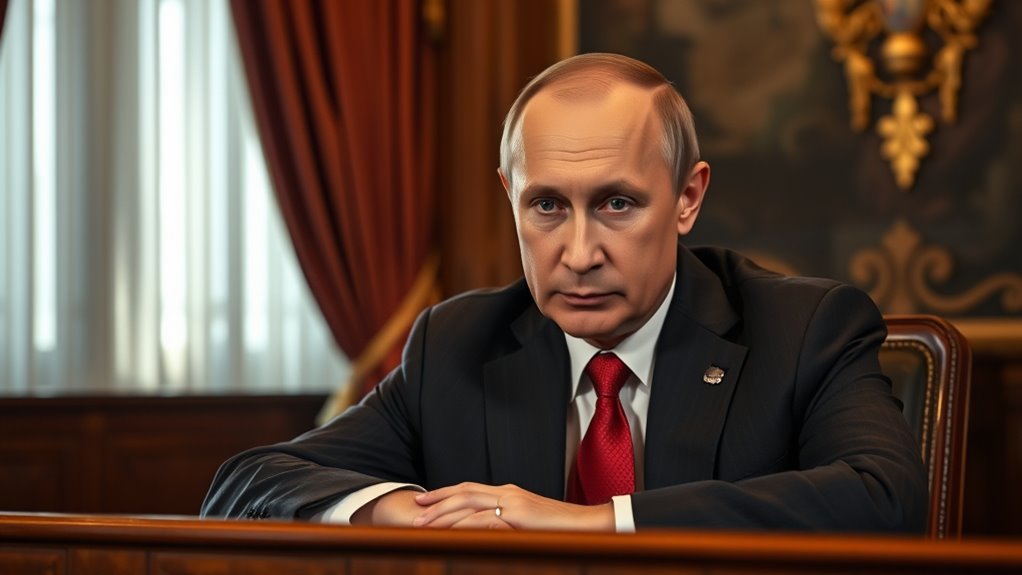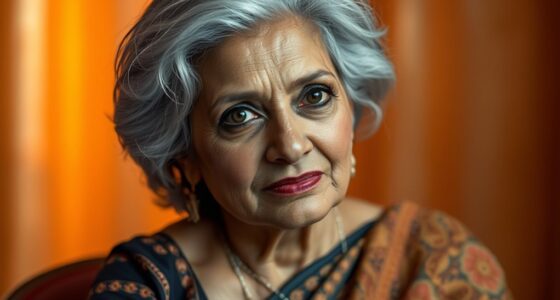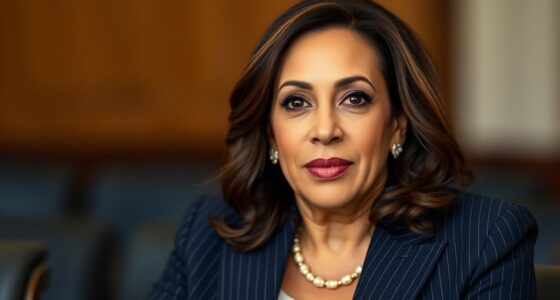Vladimir Putin has been Russia’s dominant leader for over two decades, shaping its politics, economy, and international stance. You’ll see how he rose from a military background and local government to become president, consolidating power through reforms, elections, and strategic foreign moves. His leadership includes military actions, domestic control, and efforts to restore Russia’s global influence. If you continue exploring, you’ll uncover more about his rise, policies, and future plans.
Key Takeaways
- Vladimir Putin has served as Russia’s President since 2000, with a brief tenure as Prime Minister, consolidating power through strategic reforms.
- He emphasizes strengthening federal control, suppressing opposition, and maintaining high public support through controlled media.
- Putin aims to restore Russia’s status as a major global power via military interventions and strategic alliances.
- His leadership is characterized by authoritarian governance, constitutional reforms, and efforts to prolong his rule beyond 2024.
- Putin’s image promotes strength and patriotism, while his policies significantly influence Russia’s domestic stability and international relations.
Early Life and Military Background
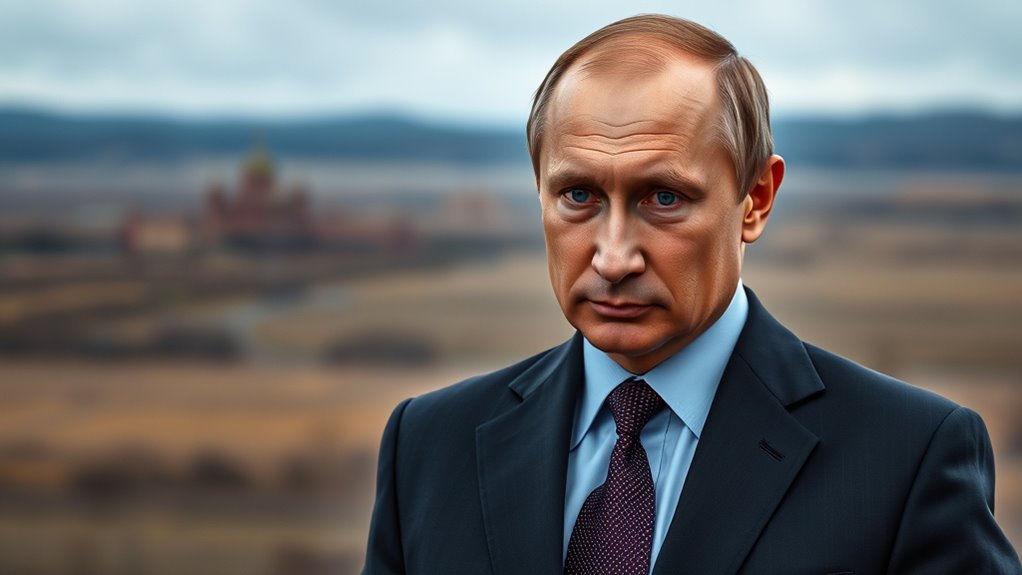
Vladimir Putin was born on October 7, 1952, in Leningrad, Soviet Union, now known as Saint Petersburg, Russia. You should know that he was the youngest surviving child in his family, with two older brothers who died early—one in infancy and another during the Siege of Leningrad in WWII. His father served in the Soviet Navy submarine fleet and later joined the NKVD, suffering severe wounds in 1942. His family endured hardships; his maternal grandmother was killed by German occupiers, and his uncles disappeared on the Eastern Front. Growing up in a communal apartment, you can see how his early environment was shaped by war and resilience. These experiences likely influenced his sense of duty and perseverance later in life. Additionally, early life experiences played a crucial role in shaping his leadership style and worldview.
Entry Into Politics and Rise to Power
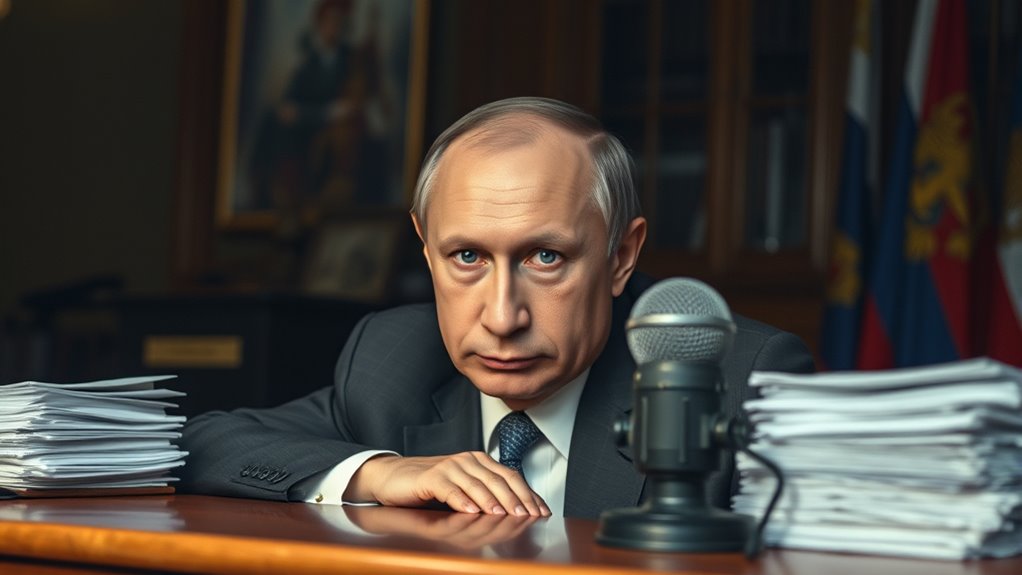
After establishing himself in Saint Petersburg’s local government between 1990 and 1996, he quickly gained a reputation as a capable administrator, helping the city develop foreign economic relations and international cooperation. In May 1990, he was appointed advisor on international affairs to the mayor, and he held various positions until 1996, building experience in municipal governance. That year, he left Saint Petersburg to pursue federal political opportunities in Moscow. By August 1996, he became deputy head of the President’s Administrative Directorate, and in March 1997, he advanced to deputy head of the Presidential Executive Office. In May 1998, he was promoted to first deputy head of the Presidential Administration. His influence grew as he took on roles overseeing government functions, building strong political networks, and increasing his visibility within Russia’s federal power structure. Hamster care costs and other factors also played a role in shaping his understanding of managing complex systems and resources.
First Presidency and Initial Reforms
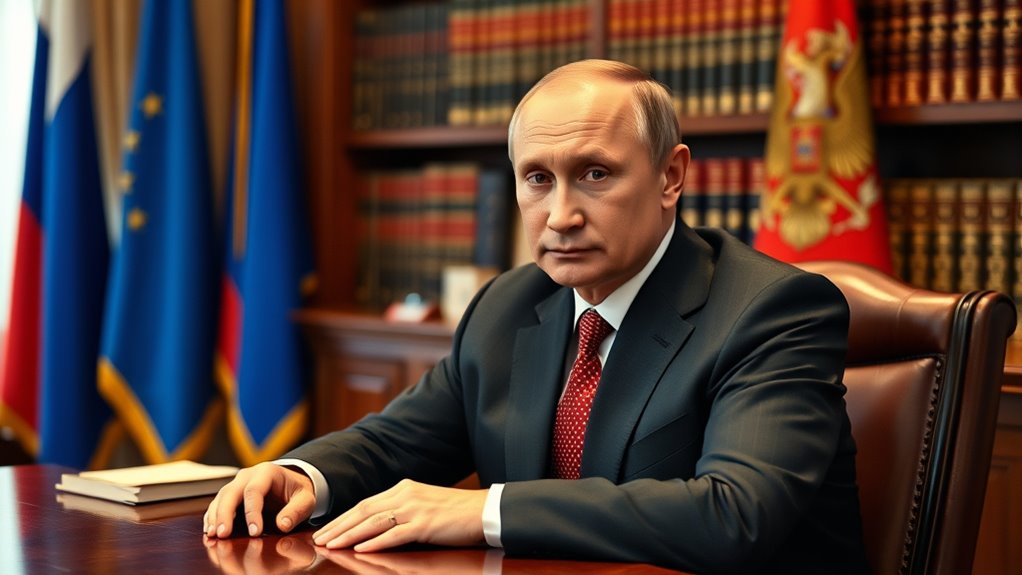
Upon assuming the presidency in 2000, significant efforts were made to centralize authority and stabilize Russia’s governance. You introduced a law allowing the president to dismiss heads of 89 federal subjects, consolidating control over regional leadership. In 2004, you replaced direct elections of governors with presidential nominations approved by regional legislatures, aiming to curb separatism and influence from organized crime. You focused on strengthening federal control, reducing regional autonomy, which drew criticism from independent media and Western observers. You also targeted oligarchs perceived as threats, exiling or imprisoning figures like Berezovsky and Khodorkovsky while maintaining alliances with others. Your reforms stabilized the economy, clarified property rights, and modernized legal codes. Security and military reforms aimed to restore Russia’s strategic strength, while judicial overhaul improved laws and government accountability. Additionally, you implemented measures to limit the influence of regional leaders, further centralizing power within the federal government.
This process also involved legal reforms that reinforced federal authority and reduced regional disparities.
Re-election and Consolidation of Authority
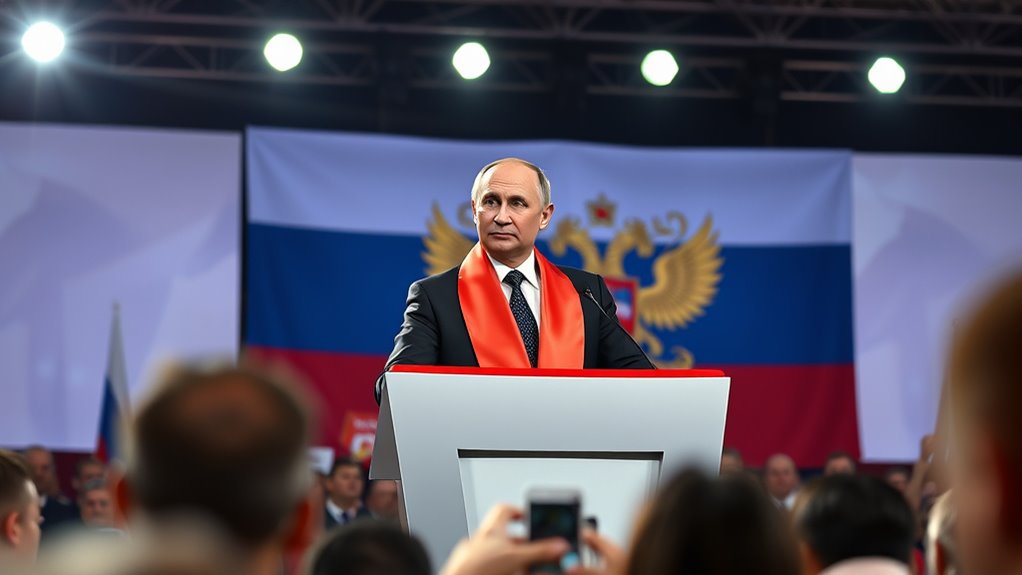
The 2024 presidential election solidifies Putin’s long-standing grip on Russian politics through a combination of constitutional reforms and tightly controlled electoral processes. You see, Putin secured about 88.5% of the votes, with turnout reaching 77.5%, demonstrating his dominance. The constitutional reform in 2020 reset term limits, allowing him to potentially stay in power until the 2030s, further cementing his authority. Key facts include:
- Overwhelming victory with near-universal support.
- Legal changes that bypass previous term restrictions.
- Controlled elections with limited credible opposition.
- State media and resources that reinforce his image.
- The election results are often viewed as a reflection of Putin’s popularity, which has remained high despite international criticism and internal challenges. The election’s outcome further consolidates his authority by discouraging opposition and reinforcing the perception of widespread support. Additionally, political consolidation strategies have been employed to maintain his dominance in various government institutions.
All these elements ensure Putin’s power remains unchallenged, transforming elections into a mere affirmation of his rule rather than genuine competition.
Role as Prime Minister and Political Strategy
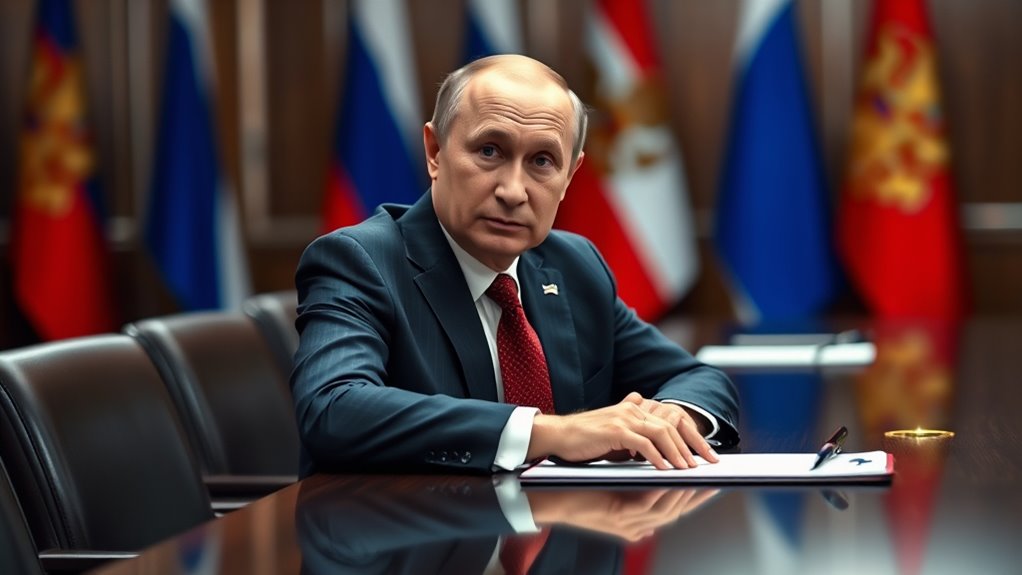
Vladimir Putin’s role as Prime Minister allowed him to maintain significant influence over Russian politics, even when he was not serving as president. From August 1999 to 2000, and again from 2008 to 2012, he used the position to shape policies and control key government decisions. During his second term, he managed to stay the true power behind the scenes, despite Dmitry Medvedev holding the presidency. Putin skillfully navigated constitutional limits by switching roles, then sponsored amendments in 2020 to reset presidential terms, extending his influence well into the future. He also controlled United Russia, consolidating loyalty and marginalizing opposition. This strategic use of the premiership and party machinery allowed him to ensure policy continuity, strengthen alliances, and prepare for his eventual return to the presidency. In his first election, Putin secured 53.4% of the vote, marking the last widely competitive presidential election in Russia. Additionally, his strategic positioning enabled him to effectively consolidate power and maintain dominance over the political landscape.
Domestic Policies and Governance Style

Vladimir Putin’s governance style is characterized by a focus on centralized power and legal reforms that reinforce his authority. You see, he’s reshaped Russia’s constitution to strengthen presidential control, including removing term limits and increasing powers for the Federation Council. You might feel the weight of these changes as they limit political competition and tighten societal control. Consider these points:
Putin’s reforms centralize power, limit opposition, and reinforce societal control through constitutional and legal changes.
- The 2020 constitutional amendments prioritize state sovereignty and make the constitution supreme over international law, emphasizing national dominance.
- Social policies, like the 2024 ban on “childfree propaganda,” aim to boost birthrates, stirring emotional debates about family and identity.
- Power is consolidated through constitutional tweaks that give the President control over judiciary appointments and law vetting.
- Cultural nationalism is reinforced by laws emphasizing the Russian language and traditional family values, shaping society’s moral fabric.
- Legal reforms have also included tightening electoral legislation and increasing restrictions on political opposition to maintain stability and control.
Foreign Policy Milestones and International Relations
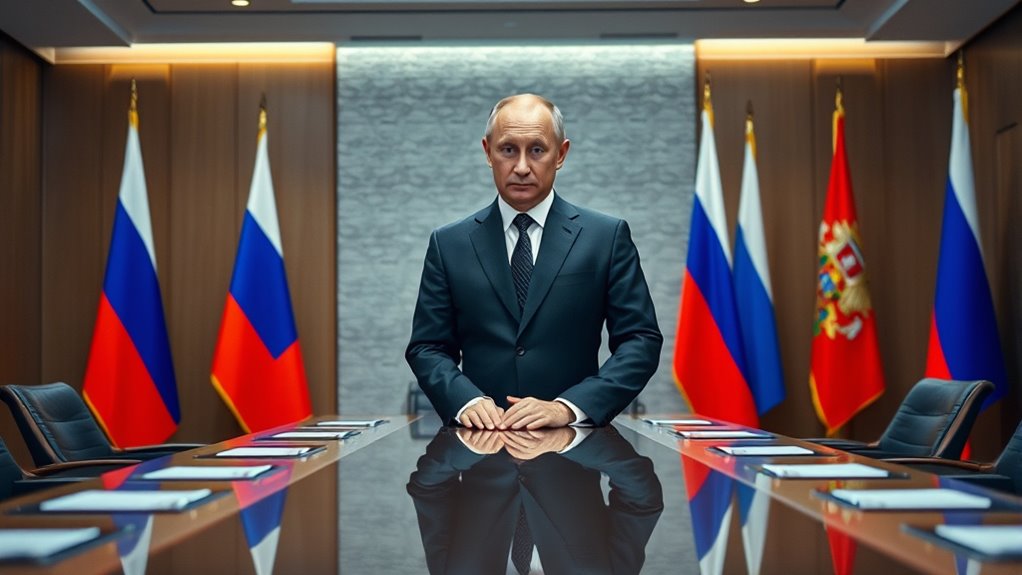
Russia’s foreign policy under Putin aims to restore the nation’s status as a major global power and reassert influence in post-Soviet Eurasia. You see this through military actions like the ongoing Ukraine operation, which demonstrates Moscow’s focus on projecting power and safeguarding its interests nearby. Public pride in Russia’s international influence is high, with 74% supporting its global role and 82% proud of military achievements. Russia balances cooperation with Western countries while preparing to resist political and economic pressures, shifting away from Soviet ideology toward pragmatic engagement. The 2015 Syria intervention marked a key milestone, showcasing military strength beyond the former Soviet space. Despite sanctions, Russia continues to build alliances, export energy, and defend its strategic interests, aiming to assert itself as a formidable global actor. Public perception of foreign policy outcomes remains largely supportive, with a majority viewing these actions as beneficial for Russia’s international standing. Additionally, Russia actively seeks to diversify its international partnerships to mitigate the impact of Western sanctions and bolster its geopolitical influence.
Handling of Security and Crisis Situations
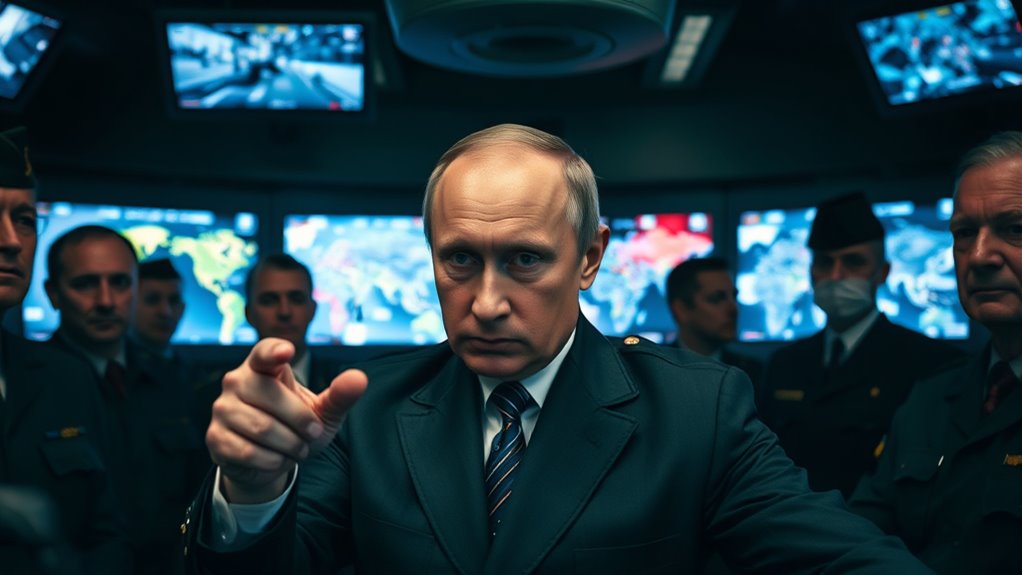
You observe how Putin’s security strategies prioritize swift, decisive responses to crises, using both military and informational tools. His administration emphasizes the effectiveness of these measures in maintaining stability and asserting Russia’s interests. By analyzing these tactics, you can better understand how Putin manages internal and external threats under pressure. These measures are often complemented by diplomatic and strategic initiatives aimed at reinforcing Russia’s sovereignty and strategic interests on the international stage. Additionally, leveraging AI security tools can enhance threat detection and response capabilities, further strengthening crisis management.
Crisis Response Strategies
To effectively manage security and crisis situations, strategic deployment of military, covert operations, and economic measures forms the core of Vladimir Putin’s approach. You see him escalate pressure through full military force, covert provocations, and economic sabotage. His tactics include:
- Using military and shadow war activities to undermine Ukraine and deter Western support.
- Reorganizing intelligence services for targeted covert operations and violent provocations.
- Draining Russia’s economy with war expenses, freezing assets, and cutting off foreign investments.
- Leveraging nuclear threats and deploying nuclear-capable missiles to threaten adversaries and deter intervention. Managing geopolitical risks is also a key aspect of his strategy to maintain strategic advantage.
He also employs diplomatic and informational campaigns to shape international perceptions and create strategic ambiguity. These strategies aim to reinforce Russia’s borders, project power, and deter external threats, all while maintaining a posture of strategic coercion that keeps opponents on edge and influences global calculations.
Security Policy Effectiveness
How effective are Putin’s security strategies in managing crises and defending national interests? They’ve shown resilience through a mix of military upgrades, hybrid tactics, and geopolitical maneuvers. By continuously modernizing Russia’s armed forces, you guarantee readiness for regional and proxy conflicts, emphasizing air power and cyber capabilities over large troop deployments. You’ve also used disinformation and cyber operations to weaken Western cohesion, while diplomatic efforts aim to reshape Euro-Atlantic security, especially in Ukraine. Territorial annexations and strategic depth bolster Russia’s security narrative, framing actions as defensive responses to Western threats. Additionally, your broad security doctrine allows for flexible nuclear use, enhancing deterrence. Effective security strategies] demonstrate a calculated approach to crisis management, maintaining Russia’s influence and stability amid evolving international challenges.
Personal Life and Public Image
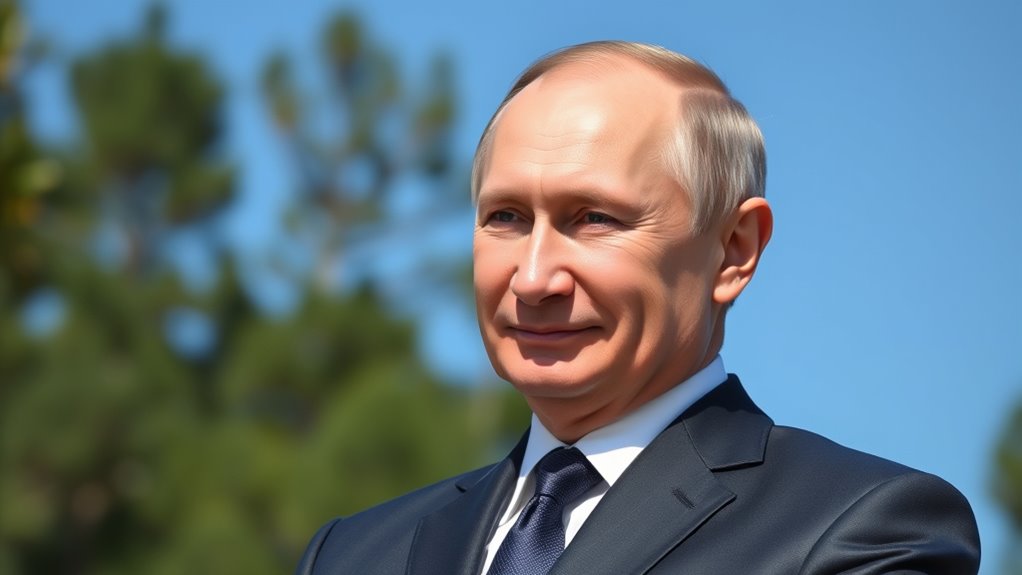
Vladimir Putin carefully cultivates a public image of strength and discipline, emphasizing patriotism and Russian nationalism. You see him often engaging in outdoor activities like horseback riding, fishing, and martial arts, reinforcing his rugged leader persona. His private life remains mostly hidden, with limited public details about his family to protect their privacy. His use of filtration technology in maintaining a controlled environment reflects his emphasis on resilience and stability.
Legacy and Future Prospects
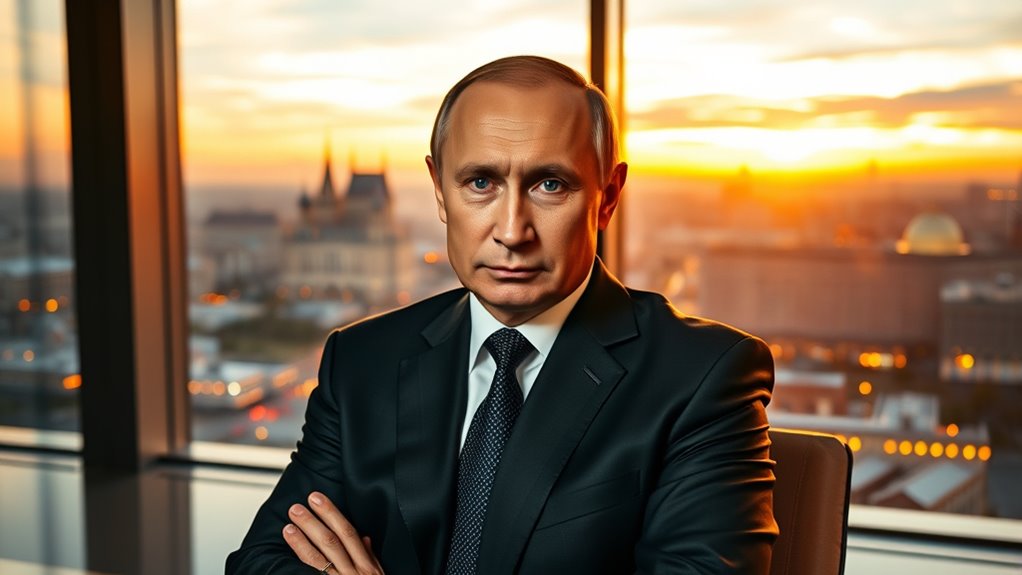
As you consider Putin’s legacy, you’ll notice how his leadership has reshaped Russia’s military, economy, and global stance, but not without lasting costs. His long-term influence will depend on how Russia manages the aftermath of the Ukraine conflict and internal stability. Looking ahead, you’ll see challenges surrounding leadership progression and whether his system can sustain itself without him. Putin’s regime has maintained stability despite economic setbacks and increased international isolation, but ongoing sanctions and military losses could threaten future resilience.
Long-Term Influence
Putin’s long-term influence will be shaped by the institutional foundations he has established and the trajectory of Russia’s political and economic systems. You can see his impact in the strengthened centralized authority and reduced regional power, securing the Kremlin’s control. His reforms have built a resilient, if authoritarian, governance model that suppresses opposition and consolidates power. Additionally, the regime’s reliance on Putin’s persona and power vertical makes succession difficult, increasing the risk of instability if internal conflicts arise. Consider these key effects: 1. A more cohesive, yet authoritarian, Russia that resists democratic change. 2. An economy heavily reliant on energy, risking future stability. 3. A geopolitical stance marked by assertive, often provocative, interventions. 4. A regime that endures through repression but remains vulnerable to elite conflicts. Your future, shaped by these legacies, depends on how Russia navigates its economic, political, and international challenges.
Leadership Transition Challenges
How will Russia navigate the complex process of leadership change after Vladimir Putin? The upcoming shift hinges on elite power rebalancing, with constitutional changes signaling Putin might step back from running again. Power could shift from the presidency to parliament or new political roles for Putin, but stability relies on elite consensus and factional dynamics rather than Putin’s direct control. Risks include elite infighting, military or security service loyalty shifts, and potential violence, making peaceful transfer uncertain. Successor prospects involve dismantling Putin’s political image while managing state resources. Domestic opposition, elite fractures, and societal protests add unpredictability. External pressures and economic factors will influence legitimacy. Overall, leadership change is likely turbulent, with factional struggles and instability overshadowing hopes for a democratic transition or long-term stability. The role of the security elite will be particularly crucial in shaping the transition process.
Frequently Asked Questions
What Are Vladimir Putin’S Long-Term Political Ambitions?
Your question about long-term political ambitions focuses on how a leader aims to stay in power and expand influence. They seek to secure their position by amending laws, weakening checks and balances, and extending term limits. Additionally, they pursue geopolitical goals like territorial control, strengthening alliances, and projecting power globally. By leveraging conflicts and strategic partnerships, they aim to maintain dominance and reshape regional and global dynamics in their favor.
How Does Putin Maintain Public Support Over Decades?
You see, maintaining public support over decades often hinges on fostering nationalism, delivering stability, and controlling the narrative. You might focus on key events that boost your image, like territorial restores, and implement policies that appeal to diverse social groups. You also keep a close eye on public opinion, using media to reinforce your popularity, while addressing social needs to build a sense of loyalty and continuity among your supporters.
What Are the Implications of Putin’S Leadership Style Internationally?
You see, his leadership style makes international relations unpredictable and tense. By asserting strong, unilateral actions, he challenges Western dominance and fosters rivalries. His approach heightens security concerns, prompts sanctions, and encourages military buildup among neighboring countries. This creates a more unstable global landscape, forcing nations to adapt quickly. As a result, alliances shift, and geopolitical conflicts intensify, leading to a less predictable and more polarized international order.
How Has Putin’S Background Influenced His Governance Approach?
Imagine a sturdy oak rooted deep in tough soil—that’s how your background shapes your leadership. Your early life in Leningrad’s communal courtyards, combined with family service to Soviet leaders, fosters resilience and loyalty. Your KGB experience is like sharpening a blade, instilling discipline and strategic thinking. This blend of hardship and intelligence training leads you to govern with control, order, and a focus on strong national pride, reflecting your formative influences.
What Future Challenges Does Putin Face as Russia’S Leader?
You face major challenges ahead, including managing economic risks like stagflation and dependence on oil exports. You’ll need to address internal divisions caused by shrinking incomes and social unrest, while steering complex geopolitical tensions with the US, NATO, and China. Prolonged conflict in Ukraine strains resources and risks internal stability. Balancing military priorities with domestic needs, you must also maintain influence in regional allies and adapt to shifting global power dynamics.
Conclusion
As you follow Putin’s journey, it’s clear he’s transformed Russia into a global powerhouse, wielding power with unmatched skill and relentless determination. His influence stretches beyond borders, shaping world events and redefining leadership itself. You can’t ignore how his reign’s complexity rivals the most intricate tapestries of history, leaving a legacy so profound that future generations will study his every move, forever captivated by his extraordinary ability to command and control on the world stage.

